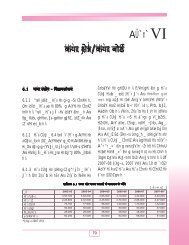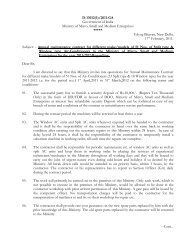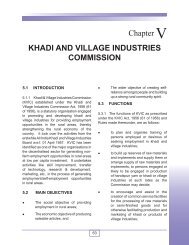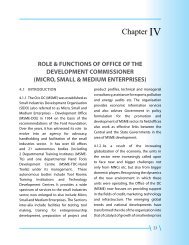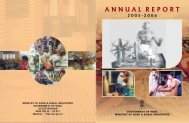Evaluation Study MSE Cluster Development - Ministry of Micro ...
Evaluation Study MSE Cluster Development - Ministry of Micro ...
Evaluation Study MSE Cluster Development - Ministry of Micro ...
Create successful ePaper yourself
Turn your PDF publications into a flip-book with our unique Google optimized e-Paper software.
Chapter No: 5– The Special Purpose VehcileAs seen in Table 5.3, we have carefully identified eight major factors that affectparticipation and involvement and compiled the responses obtained on these factors.These factors include risk aversion, financial constraints, awareness regarding thebenefits, lack <strong>of</strong> contact, skepticism regarding the viability and sustainability <strong>of</strong> the CFC,fear <strong>of</strong> the monopoly and dominance <strong>of</strong> strong and more influential players, the free riderproblem, and the appropriateness <strong>of</strong> the CFC.Table No.-5.3: PARTICIPATION AND INVOLVEMENT IN SPVsSl. Factors AffectingParticipation% Distribution<strong>of</strong> ResponsesResponses <strong>of</strong>SPVsResponses<strong>of</strong> <strong>Cluster</strong>Actors1. High Risk Aversion 10 90.90 29 93.54% Distribution<strong>of</strong> Responses2. Financial Constraints 9 81.81 26 83.873. Lack <strong>of</strong> Awareness 7 63.63 23 74.19regarding Benefits4. Lack <strong>of</strong> Contact 5 45.45 15 48.385. Skepticism andDoubts regardingViability6. Fear <strong>of</strong> the Monopolyand Dominance <strong>of</strong> afew7. Free Rider Syndrome(or benefitting bythe effort <strong>of</strong> others)8. Common Facility NotAppropriate (notevolved on the basis<strong>of</strong> concerns)11 100.00 28 90.323 27.27 25 80.658 72.72 14 45.162 18.18 23 74.19As seen in the table there is a fairly high degree <strong>of</strong> agreement among the two sets <strong>of</strong>respondents on some factors such as risk aversion, financial constraints, lack <strong>of</strong>awareness, skepticism regarding viability, and the free rider problem. The highestdegree <strong>of</strong> agreement on the above issues is on factors such as skepticism regardingviability, risk aversion, the free rider problem, and the lack <strong>of</strong> awareness regardingbenefits. The highest degree <strong>of</strong> disagreement is seen to exist on factors such as theappropriateness <strong>of</strong> the CFC and the fear <strong>of</strong> monopoly and dominance <strong>of</strong> a few strongplayers. The identification <strong>of</strong> these factors should enable the policy makers tospecifically direct efforts that will effectively lower the impact <strong>of</strong> such factors, if notremove them altogether. The most feasible policy strategy to effectively solve some <strong>of</strong>these rather intractable problems would be to permit and support the formation <strong>of</strong> subclusters and SPVs in order to lower the effects <strong>of</strong> homogeneity based on size and scale <strong>of</strong>individual units. However this would only apply to large and dense clusters with a highdegree <strong>of</strong> viability and sustainability. It should also be emphasized that the guidelinesand norms related to the SICDP and particularly those related to the role and functions<strong>of</strong> the SPV in the creation, management and sustenance <strong>of</strong> the CFC should be99





